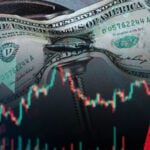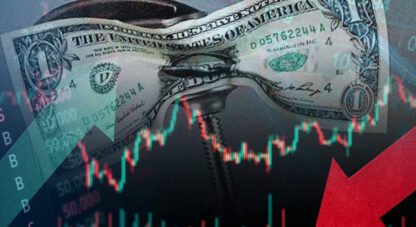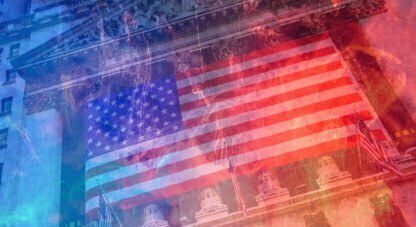Podcast: Play in new window
From Big Squeeze to Banking Crisis.
Disclaimer: Advisory services are offered by McAlvany Wealth Management, an investment adviser registered with the U.S. Securities and Exchange Commission. The comments made in this audio recording discuss economic and market trends and are not intended as advice for any particular investor. A short selling strategy involves a substantial degree of risk. Any decision to engage in a short selling strategy should be reviewed with your financial adviser. Past performance is no guarantee of future results.
MWM Q1 2023 Tactical Short Conference Call
April 20, 2023
David McAlvany: Okay. We are ready to go. This is David McAlvany. Thanks for joining Doug Noland and the team for comments on Tac Short. This is our first quarter conference call, April 20th, 2023, titled From Big Squeeze to Banking Crisis.
As we go through the comments today, if there’s questions that emerge, topics that you’d like for us to expand upon, feel free to send those questions to [email protected]. Again, that’s Ted, T-E-D, at McAlvany, M-C-A-L-V-A-N-Y, .com.
Good afternoon to all of you. We appreciate your participation in our first quarter 2023 recap conference call. Special thank you to our valued account holders. We greatly value our client relationships.
With first-time listeners on today’s call, we’ll begin with some general information for those unfamiliar with Tactical Short. If you’re looking for more detailed information, that is available at mcalvany.com/wealth. The Tactical Short product is outlined there, and of course I’m available, Doug is available, with very specific questions regarding use of Tactical Short as a hedging strategy or complement to your existing portfolio suite.
The objective of Tactical Short is to provide a professionally managed product that reduces the overall risk in a client’s total investment portfolio, while at the same time providing downside protection in a global market backdrop with extraordinary uncertainty and extreme risk.
This strategy is designed for separately managed accounts. On that basis, it is very investor-friendly with full transparency, flexibility, reasonable fees, and no lockups. We have the flexibility to short stocks and ETFs. We also plan, on occasion, to buy liquid listed put options. Shorting entails a unique set of risks. We are set apart both by our analytical framework as well as our uncompromising focus on identifying and managing risks in real time.
Our Tactical Short strategy began the quarter with the short exposure targeted at 78%. The target was reduced to 76% early in the quarter and then raised to 79% after the banking crisis eruption. Focused on the extremely challenging backdrop for managing short exposure, a short in the S&P 500 ETF SPY remained position for high-risk environments.
The first quarter market environment further validates why we do not encourage aggressive bets against the stock market. As we stress during each call, remaining 100% short all the time, as most short products are structured, is risk indifference. Aggressive shorting can at times be very rewarding, but the market over recent years and again during the first quarter inflicted painful losses on the short side for those that did not manage risk very, very tightly.
We believe disciplined risk management is absolutely essential for long-term success. We structured Tactical Short to ensure the flexibility to navigate through even the most challenging market conditions, and certainly the first quarter of this year presented a few of them.
I’ll give you an update on performance, and then pass along for more specific market comments to Doug. Then we’ll circle back around to your questions at the tail end. We have a list already submitted. Again, if you have any that you would like to submit between now and the end of our remarks, [email protected], and he’ll forward those to us to include in the queue.
Updating performance: Tactical Short accounts, after fees, returned negative 5.41% during Q1. The S&P 500 returned deposit of 7.48%. So looking at those as a percentage, for the quarter Tactical Short accounts lost 72% of the S&P 500’s positive return. As for one-year performance, Tactical Short, after fees, returned a positive 5.27% versus the negative 7.75% return for the S&P 500. On that basis, again, in percentage terms, Tactical Short returned 68% of the S&P 500’s negative return.
We regularly track Tactical Short performance versus three actively managed short fund competitors. First, the Grizzly Short Fund, which returned a negative 10.85% during Q1, and over the past year Grizzly returned a positive 4.09%. Ranger Equity Bear returned a negative 11.55% for the quarter, with a positive 4.01% for a one-year return. Then Federated Prudent Bear returned a negative 6.81% during Q1 and a positive one-year return of 7.88%.
Tactical Short outperformed all three actively managed short funds during the quarter, with average outperformance of 432 basis points, and Tactical Short outperformed two of the three funds over the past year. Tactical Short has significantly outperformed each of the bear funds since inception, which for us was February 6th— I apologize, April 7th, 2017. That runs through the end of March of this year.
Tactical Short returned a negative 40.6% versus the 93.85% return for the S&P 500. On average, we were outperforming our three competitors by 2,706 basis points, or 27 percentage points. There are also the popular passive short index products. The ProShares Short S&P 500 ETF returned a negative 5.69% for the quarter and a positive 7.63% for the past year.
The Rydex Inverse S&P 500 Fund returned a negative 5.66% during Q1 and a positive 7.38% for the one-year returns. Then the PIMCO StocksPLUS Short Fund with a one year—I’m sorry—with a Q1 return of negative 5.65% and a one-year return of a positive 6.81%.
That covers performance, and I’ll make a showing towards the tail end with Q&A. Doug, over to you.
Doug Noland: Thanks David. Good afternoon everyone. Thank you all so much for being part of our call today.
On recent calls, I’ve typically begun by noting how it was yet another extraordinary quarter. We’ve all surely become numb to how extraordinary things are. We’re living through a critical period of history in real time.
The quarter started with a powerful cross-asset short squeeze—stocks, bonds, corporate credit to cryptocurrencies. In the face of economic resilience and persistent inflation, market yields nonetheless sank to start the year. After beginning January at 3.88%, 10-year Treasury yields were down to 3.37 by mid-month.
Shorting Treasurys had become one gigantic crowded trade, with huge hedging-related shorts, along with bearish speculative bets. An intensifying short squeeze and unwind of hedges that began in Q4 significantly bolstered marketplace liquidity, with loosened conditions stoking a powerful equity squeeze.
At its February 2nd peak, the Goldman Sachs Short Index had gained 35% year to date. The NASDAQ 100 was up 18%, the mid-caps 12%, and the small caps 14%. All significantly outperforming the 9% S&P 500 gain. Last year’s big winning macro trades, including shorting tech, stocks, Treasurys, corporate credit, and crypto, all reversed sharply higher.
But so much abruptly changed in March with the eruption of banking system instability and two of the three largest bank failures in US history. I’ll return to the spectacular Silicon Valley collapse and banking crisis. As a segue to our performance discussion, I’ll highlight pre-crisis stock trading in Silicon Valley Bank, or SVB, as an illustration of how challenging the quarter was on the short side.
Imagine you were an ace short-side bank analyst having astutely researched SVB’s balance sheets, security holdings, and asset liability mismatch. You were convinced SVB was in trouble, with 100% conviction. It was your favorite short, and you came into the quarter with an outsized short position.
Well, at its February 2nd peak, the stock had surged 48% year to date. The number of shares sold short had increased 60% during Q4, just in time to get slammed by a major squeeze. While some shorts could have had the staying power, we can assume that many reversed their losing short bets weeks or even days prior to the stocks’ stunning collapse.
SVB provides a cogent example of the ongoing difficult environment for shorting individual company stocks. It’s no coincidence that the two actively managed competitor short funds that focus most on individual company analysis posted the worst performance for the quarter. I’ll add that these funds were fortunate the banking crisis unfolded when it did.
As of February 2nd, one fund had already suffered a year-to-date loss of about 24%, and the other almost 15%. These two funds, having somewhat outperformed in the 2022 down market after Q1 losses, have underperformed Tactical Short over the past year. And that’s how this can work, and why it’s especially critical on the short side to be a disciplined risk manager.
Managing short exposure volatility is essential, and you can’t let your guard down. And I’ll add that this type of instability and market volatility is a hallmark of pre-crisis environments. As was the case with SVB, squeezes and bear market rallies often create challenges right as the bear thesis is coming to fruition.
These two funds manage high-beta, more volatile short portfolios, and such a risk profile came back to bite short side investors again during Q1. On average, these two funds lost 144% of the S&P 500’s positive return for the quarter. Double Tactical Short’s 72% mentioned by David.
For Tactical Short and high-risk environments such as the one we’ve been operating in, we’re not going to run a high-beta portfolio. We’ve been anticipating wild markets, extreme uncertainty, volatility, and general instability. In this environment, the odds of major squeezes are unusually high.
Arguably, these are the most speculative markets since the late 1920s. There are tens of millions of online accounts trading stocks from home. American households, enamored by the perceived liquidity and safety of ETFs and enthralled with options trade, have never been as active in the markets. There are individual hedge funds with tens of billions of assets, and investment companies with trillions, all aggressively playing the game.
A record 68 million option contracts traded on the CBOE on February 2nd, the peak short squeeze day I mentioned. 3.2 billion options were traded last year on the CBOE, the third consecutive annual record. Volume on individual company options has doubled since 2019. Yet no option category has enjoyed such breakneck growth as ultra-short-term options, so-called zero DTE, or zero days to expiration, options.
Meanwhile, there’s the multi-trillion dollar global leveraged speculating community, the hedge funds, family offices and such. We’ve witnessed a proliferation of quant funds and algorithmic trading that tend to be trend-following momentum traders. In general, the institutional investment management complex has become heavy users of trend-following models and derivative hedging strategies, and especially after the Fed-induced COVID crisis rally.
There’s a cottage industry of institutions and online traders dedicated to targeting short positions given any opportunity. Putting it all together, there’s no surprise here that markets have turned so acutely speculative and unstable, unpredictable.
Let’s return to Silicon Valley Bank. To begin, I’ll share some relevant data that I hope brings some perspective to the unfolding banking crisis. At 25.6 trillion, total banking system assets ended 2022 almost double 2007. Bank assets ballooned an unprecedented five and a half trillion, or 28%, just over the past three years.
The Federal Reserve’s balance sheet inflated five trillion on the back of COVID stimulus. Keep in mind that QE comes with disparate dynamics and impacts. 2008 crisis QE was mainly the Fed creating new money to accommodate deleveraging, providing liquidity to financial institutions and speculators so they could de-risk and pay down debt.
The pandemic five trillion QE was altogether different. Not only was it not part of deleveraging, but massive monetary inflation incentivized risk-taking and speculative leverage. The Fed flooded the system with unprecedented liquidity that, to a large extent, led to the creation of trillions of new bank deposits.
What did the banking system do with this deluge of deposit money? They loaned aggressively and loaded up on more securities. Worse yet, this massive monetary inflation came after years of credit bubble excess. Too much of the recent lending boom was of the late cycle high-risk variety.
It was too often directed at the bevy of uneconomic enterprises that proliferated throughout this boom, as well as financing loans to overpriced office buildings, multi-family housing, and all types of commercial properties. Moreover, much of the portfolio buying was Treasury and agency securities whose market prices had been inflated by the Fed’s zero rate and QE policies.
At SVB, commercial loans were up 140% in three years, while its securities portfolio surged fourfold from 29 billion to 120 billion. Deposits doubled to 81 billion. SVB, it’s somewhat of an outlier, yet total banking system Treasury holdings jumped 80% in three years. Corporate bonds, 49%, and agency and MBS—mortgage backed security—holdings, 20%.
Bank loans last year increased an unprecedented 1.4 trillion, or 11.3%, more than doubling the previous annual record from 2015, with loan growth almost double peak annual lending during the mortgage finance bubble period. Such late cycle excess ends badly, ominously.
We’ve already witnessed the eruption of a banking crisis with major runs and failures despite only three and a half percent unemployment, positive GDP growth, and so far uninterrupted credit expansion. The crisis was kicked off with security portfolio losses and deposit flight.
Severe credit issues will be forthcoming. We’ll see more judicious bank regulators along with nervous lending officers and bank managements. Standards will tighten, and loan growth will slow, marking a major inflection point in what have been historic credit and economic cycles.
For the here and now, I’ll highlight recent incredible market instability, a key late-cycle manifestation of what I refer to as monetary disorder. Two-year Treasury yields as high as 5.07% in early March dropped to as low as 3.71% on March 15th. In three sessions, market expectations for the Fed’s policy rate in December collapsed almost two full percentage points, from 5.67% to 3.73%.
This rate is now back up to 4.64%, with 2-year Treasury yields having recovered to almost 4.2%. Markets were quick to price in a crisis, or at least a recession and dovish Fed pivot.
David McAlvany: Doug, expand if you would on the new lending facility.
Doug Noland: Sure, David. Yeah. The Fed moved. They moved immediately to establish a new lending facility, while the failures of SVB and Signature were deemed as a sufficient systemic risk for the unusual action of protecting even uninsured deposits at these banks.
Yellen has waffled on the issue, but at this point there appears an implicit blanket guarantee of US bank deposits. The Fed also bolstered swap lines with foreign central banks. Clearly, Washington officials had real fear that the banking run could spiral out of control. The upshot: more desperate measures to thwart bubble collapse.
Federal Reserve assets surged 364 billion in three weeks, reversing two-thirds of eight months’ worth of quantitative tightening. Importantly, it appears the Federal Home Loan Banks, or FHLB, expanded member lending an additional 400 billion. This was an extraordinary amount of liquidity quickly injected into the system, rivaling the panicked 2008 response.
Over the past five weeks, money market fund assets surged 384 billion to a record 5.3 trillion, with year-to-date growth of 463 billion, or 42% annualized. The SVB-related bank run dynamic, it is different than the 2008 run on Lehman Brothers repo and money market obligations.
However, there are today unsettling parallels to the backdrop heading into the great financial crisis. Not coincidentally, when the subprime mortgage crisis erupted during Q3 2007, FHLB loans and advances surged a record 180 billion. Over the five quarters, Q3 ’07 through Q3 ’08, total Government Sponsored Enterprise, or GSE, assets inflated a record 1.6 trillion. Powered by the GSEs, financial sector borrowings expanded an unprecedented 2 trillion, or almost 14%, in 2007.
I know, these numbers, they can be numbing. But the key point is that in response to the initial piercing of the mortgage finance bubble, the GSE stepped up to provide massive liquidity in their liquidity backstop operations. Financial sector debt expanded rapidly, taking up the slack from incipient marketplace deleveraging.
I’ve argued that these operations only work to extend the terminal phase of bubble excess, in the process exacerbating market financial and economic fragilities. Clearly, GSE liquidity operations didn’t prevent crisis in 2008. Instead, risk became only more precariously concentrated in a rapidly ballooning financial sector.
Last year, GSE assets expanded an annual record 921 billion to 9.2 trillion as total financial sector borrowings increased 1.8 trillion. These were by far the largest expansions since fateful 2007. I expect record Q1 growth in GSE assets, perhaps surpassing 500 billion.
Extraordinary lending by the Fed and GSEs is extending the cycle. But I fear the consequences will be similar to ’08 —acute monetary disorder and more fragility for speculative markets, the financial system, and the bubble economy. For more than a decade, I’ve referred to the global government finance bubble, and we see today a system dominated by government finance—the Federal Reserve, the Treasury market, and the GSEs.
From my perspective, it’s runaway debt growth that will prove difficult to contain. The federal deficit surged to 378 billion last month, almost double March ’22. Halfway through the fiscal year, the deficit has already reached 1.1 trillion, 65% higher than comparable 2022.
David McAlvany: Doug, where are the bond vigilantes? What about the bond market enforcing some form of discipline on DC?
Doug Noland: Yeah. I guess we’ll have to wait for the bond vigilantes, David. My hopes that higher bond yields might impose some discipline on Washington, they’ve been dashed as the bond market now prepares for some type of accident. Markets are pricing a 50-basis-point reduction in the Fed’s policy rate before year-end, while Fed officials rather adamantly stick with higher for longer.
The way I see it, it’s not so much that the market is expecting a couple of rate cuts. As it is, the market is pricing probabilities of a major development forcing the Fed into a dovish pivot—think in terms of the market seeing, say a 50% probability of an accident that would induce a hundred-basis-point cut, or perhaps a 25% probability of crisis forcing the Fed to slash rates 200 basis points.
With the current backdrop quite conducive to a market accident, rate cuts this year are a distinct possibility. But I don’t expect the Fed to be in as much of a hurry to pivot as markets anticipate. For starters, the Fed has again injected significant liquidity when they were supposed to be removing it to fight inflation.
Moreover, this latest shot has spurred another short squeeze and unwind of hedges, creating liquidity for loosened market conditions. Risk-on has the potential to again complicate the Fed’s inflation fighting efforts.
Brief comments on inflation: Fortunately, price gains have come off the boil. However, inflation pressures persist. Labor markets remain tight, and wage gains elevated. Crude oil and gas prices reversed higher after unexpected OPEC production cuts.
We believe there are significant structural issues that ensure ongoing risk of heightened price pressures. These include deglobalization and trade frictions, persistent supply chain challenges, myriad factors associated with climate change, and constrained supplies of many global commodities.
We continue to see corroboration of our new cycle thesis. While markets assume the Federal Reserve will swiftly slash rates back towards zero in a crisis environment, there are reasons Fed officials might move cautiously this cycle. Even in an economic slowdown, we expect inflationary pressures to prove sticky.
The ongoing inflation scare will not be soon forgotten. Moreover, banking and market upheaval will ensure the Fed has no alternative but to once again significantly expand its balance sheet. This could leave Fed officials wielding their rate-cutting tool less zealously. Besides, at this point, even the Federal Reserve recognizes that low interest rates come with major unintended consequences.
Importantly, the SVB crisis exposed a key risk that has grown stealthily throughout this boom. With a simple keystroke, depositors, investors, and speculators can instantaneously exit a position. No need to drive to your local branch and get in a long line to participate in a bank run.
Some years back, I introduced the moneyness of risk assets concept—an evolution from the moneyness of credit that was at the heart of the mortgage finance bubble. Government policies—Fed and GSE liquidity backstops in particular—have instilled the perception of safety and liquidity upon a large cross section of financial market risk assets, including stocks and corporate credit.
I view the incredible ongoing surge in money market fund assets and ETF shares as creating particular vulnerability. Money fund assets have expanded 1.44 trillion, or 38%, since 2008, with the ETF complex inflating more than tenfold from 600 billion to six and a half trillion. A sudden shift in perceptions of safety and liquidity, along with millions of nearly simultaneous keystrokes, and immediately there are highly destabilizing runs on trillions of market holdings.
In previous calls, I have discussed the risk posed by dynamic hedging of derivative positions. Those that have sold derivative hedges must, in a declining market, sell instruments to have the required cash flow for payouts, creating the risk for cascading sell orders to overwhelm marketplace liquidity.
In the event of a run on money funds and/or ETFs, the concurrent triggering of massive derivative-related selling would quickly lead to market dislocation. At this point, these risks are disregarded because of faith in the Fed liquidity backstop. I fear it is because of Fed and GSE backstops that this crash risk has been building for years.
I believe the great bubble has been pierced with policy measures only delaying the day of reckoning. After a historic lending boom, banks will now pull back. SVB was at the heart of finance for startups, providing a lifeline for scores of negative cash flow companies. Overall, the first quarter saw dramatic drops in both venture capital finance and private equity.
There are also cracks in so-called private credit, illustrated by redemption issues with Blackstone’s 70 billion BREIT fund and similar vehicles. There are also holes in decentralized finance and ongoing issues with crypto.
David McAlvany: A quick comment on commercial real estate. A $20 trillion market with close to 2.3 trillion of that attached to mid-size banks, and we’re going to need liquidity flowing—and that’s actually what we’re up against. We’ve got rollover here of $400 billion in commercial real estate in 2023, $500 billion in 2024, and $600 billion in 2025.
We’ve got an issue with the banks stepping up to refinance that. At the same time, commercial mortgage backed securities issuance is down 85%. It was 42.8 billion in the first quarter of 2022. So far, we’ve seen about six and a half billion. An 85% decline in CMBS issuance, not exactly liquid in a timeframe where you need the liquidity flowing for commercial real estate.
Doug Noland: That’s right, David. Thanks for that important data there. Yeah. Stress is mounting rapidly throughout commercial real estate. Banks and insurance companies are backing away from the office building marketplace, while property buyers have turned risk averse.
With the money spigot being turned down after years of excess, expect a steady drumbeat of bad news. Multi-family transactions have also slowed sharply, with even indications of waning investment demand for single family homes.
Everyone has grown accustomed to economic resilience, but it really has been the unheralded force of powerful credit expansion driving growth dynamics. Even last year, with security markets under pressure, the irrepressible US economy hardly missed a beat. It didn’t miss a beat because of record bank lending. I believe Q1 marks a major credit bubble inflection point. Bank lending will now slow.
Currently, buoyant security markets are providing an uptick in bond issuance, for now somewhat offsetting the bank lending downturn. But tightened bank finance can be expected to transmit to tighter market conditions, risking significant credit weakening.
A credit downturn after such a historic boom cycle is sure to come with a parade of negative surprises. First, it was crypto and FTX. During the quarter, instability erupted in the riskier banks. Now tighter credit [unclear] scores of negative cash flow startups and uneconomic business models. More generally, a restrained credit environment will finally begin to expose the severe economic structural maladjustment that comes from years—no, even decades—of excessively loose finance.
As I’ve explained in the past, the government finance bubble is the end of the line. There are no other credit sources to be expanded sufficiently for reflating the next bubble. The Q1 reflation of the Fed’s balance sheet confirms system fragility, while supporting my view that the Federal Reserve will be forced to aggressively expand its balance sheet to keep a deeply maladjusted financial sector liquid.
Furthermore, the six-month trillion dollar federal deficit is a harbinger of things to come. Gold surged $145, or 8%, during the quarter as the dollar declined 1%. Gains in the shiny store of value are consistent with our view of heightened financial stability concerns. Both the Fed and Treasury are trapped in inflationary policymaking.
I fear the Fed’s balance sheet will inflate by trillions come the next serious de-risking, de-leveraging episode, and I would not be surprised by $2 trillion annual fiscal deficits as far as the eye can see.
For years, the dollar has withstood misguided policymaking and perpetual current account deficits. Our currency has been underpinned by the global perception that US finance is sound, and Federal Reserve operations ensure robust security markets. I fear the dollar is now vulnerable to shifting perceptions.
As far as deficits go, the federal government has company. The latest projection has California facing a 22 billion fiscal hole—an alarming deterioration from a recent $100 billion surplus. Deflating bubbles are in the process of radically altering the fortunes of governments, financial institutions, businesses, and households.
The new cycle presents challenges but also opportunities. We believe an unfolding crisis of confidence in policymaking and finance bodes particularly well for the precious metals. We also expect new cycle dynamics will support significant hard asset outperformance relative to financial assets.
I need to spend a few minutes on China. I continue to be astonished by Chinese developments. It’s still difficult to believe that Xi Jinping has chosen to closely align China with the likes of Russia, Iran, Pakistan, and North Korea. That he is willing to embrace his partner without limits after Putin’s brutal Ukraine invasion speaks to how determined he is to pursue new world order transformation to counter the US.
The geopolitical environment is today fraught with risk, perhaps extreme risk. Putin is not backing down in Ukraine. While we’ve grown numb to it, Putin’s nuclear sabre rattling is turning only more alarming. He is positioning nukes in Belarus while testing nuclear capabilities in the Pacific. I’m assuming the odds Putin would actually resort to nuclear are low, though probabilities of some type of nuclear blackmail increase as the war grinds on.
Relations with China are also at new lows. It’s only a matter of time before Xi moves on Taiwan, though most analysts believe military confrontation is still a few years off. Recent Chinese military drills rehearsed the enforcement of a full island blockade—a scenario top Taiwanese officials have warned is more likely than outright military invasion.
Last week, Chinese military officials stated they were ready to fight, a declaration seemingly directed more at Washington than Taiwan. China’s defense minister met with Putin, where Russia and China announced closer military cooperation and a deepening partnership.
This is a critical juncture for China. Their historic bubble has been pierced with severe stress enveloping the massive developer industry and the Chinese economy more generally. In a world that now views banks more guardedly, China’s bloated $60 trillion banking system is vulnerable.
Their economy had started a freefall late last year, provoking extraordinary measures from Beijing. They instituted a comprehensive stimulus plan, loosened monetary policy, and dropped zero COVID. With last week’s data, it became beyond a doubt to me. Beijing is absolutely determined to do everything possible to resuscitate China’s economic boom.
China’s aggregate financing—and that’s their metric of system credit growth—expanded a much stronger than expected 780 billion just last month. A huge March put Q1 aggregate financing growth at an incredible 2.1 trillion. This was the largest-ever three-month growth in Chinese credit, surpassing even the COVID crisis response.
Not many years ago, 2 trillion of credit growth would’ve been a banner year. Now it’s done in a span of 90 days. Chinese officials are trapped more deeply in bubble dynamics than even we are here in the US. Beijing has done an about-face. They’ve clearly thrown in the towel on reining in credit excess, caution thrown to the wind.
To dump this amount of new credit on such a deeply maladjusted system is playing with fire, a gamble that makes me uncomfortable. It is, however, consistent with the view that Xi’s global ambitions have become China’s top priority. He needs a stronger economy as he forges trade and military alliances to counter the US and west.
Uninterrupted growth is necessary to further expand his military and global superpower ambitions. In what was a notable escalation of rhetoric, Xi last month took a direct swipe at the US, saying, “Western countries led by the United States have implemented all-around containment, encirclement, and suppression against us, bringing unprecedentedly severe challenges to our country’s development.”
In the following week, Bloomberg reported similar from the People’s Bank of China, where the PBOC will, “Appropriately respond to the containment and suppression of the US and western countries.” This statement was released following, “A meeting to study Xi’s speeches during the National People’s Congress session.”
I can only shake my head. These comments speak to an irreparably damaged China-US relationship. It was the most direct effort by Xi to cast blame upon the US for China’s expanding problems. I’ve long feared that China’s bursting bubble would somehow see Beijing holding its US and Japanese adversaries responsible. Well, it’s happening.
At the minimum, it’s doubtful that the Fed and PBOC will be on the same page with crisis management cooperation as they were in 2008. I hope I’m wrong on this. But I’m compelled to share a fear. Beijing is now in full crisis management mode. They’re expending tremendous resources to restart their boom, fighting a deflating bubble with all the might the Communist Party can muster.
Beijing is working 24/7 to build alliances to counter US global power and influence. They are executing a comprehensive plan for economic revival at home and profound change globally. Meanwhile, Beijing is also preparing for plan B. Sure. Massive stimulus and state-directed lending can ensure China meets near-term GDP targets. I just don’t see China escaping bubble dynamics.
Indeed, the more egregious this late-cycle monetary stimulus, the more perilous their predicament. I worry about China’s plan B. Beijing is clearly preparing its military and people for confrontation with the US. A conflict I fear will be increasingly likely when China’s economic gambit falters.
Xi and the Communist Party will never accept responsibility for so mismanaging China’s financial system, its economy, and international reputation. Crisis will have Beijing pressing the Taiwan issue, deflecting attention and responsibility, while increasing the odds of a direct showdown with the US.
I’ve discussed previously how boom periods engender perceptions of an expanding global pie. Cooperation, integration and alliances are seen as mutually beneficial. But when the cycle turns, the pie is increasingly viewed as stagnant or shrinking. Zero-sum game thinking dominates. Insecurity, animosity, disintegration, fraud alliances, and conflict take hold.
We are in a period of momentous change. A historic global bubble has begun to deflate. The war in Ukraine has unleashed pernicious forces that will be difficult to control. China’s autocratic communist government has towering ambitions inflated by a historic bubble that is now leaking a lot of air. Japan has a new central bank governor that will need to end a historic monetary experiment that was for a decade left to run wild.
Across the globe, economies big and small, wealthy and poor alike, confront unprecedented debt overhangs. Policymakers almost everywhere face the predicament of elevated inflation and weakening growth prospects. We’re at a critical juncture in the global bubble, where acute fragility is forcing another round of desperate measures meant to hold crisis dynamics at bay.
We’ve, over recent quarters, witnessed major instability and volatility. I suspect this has become the new normal. We should be prepared for the environment to turn only more uncertain and tumultuous, with odds rising for a major accident.
In conclusion, I see developments at home and abroad corroborating the new cycle thesis. I just wish I could be more optimistic about future prospects. A lot has to go right, and we need lucky breaks to avoid a destabilizing downturn. So much is uncertain.
However, there’s one thing I am certain about. Additional monetary inflation and massive government deficit spending are not the answer. They only make things worse. David, back to you.
David McAlvany: Thanks Doug. Q&A. I’ll send the first one over to you. “What would it take to deleverage the financial system?” This is from Dave.
Doug Noland: We’re starting with an easy question, David. Yeah. Thank you for the— This is an interesting question. It’s not an easy question. From a top-down perspective, the first step in deleveraging would be to slow system credit growth. You’ve got to start somewhere. It’s the old: If you want to get out of a hole, you’ve got to stop digging.
We saw the financial sector deleveraged following the 2008 crisis. The biggest impact was from QE, where the expansion of the Fed’s balance sheet accommodated de-leveraging from troubled institutions. It’s basically just a shift of assets from institutions to the Fed’s balance sheet.
Many financial companies also wrote off impaired assets while reducing liabilities as part of de-leveraging. Here’s where the analysis turns more complex. The financial sector tends to expand rapidly late in the cycle. This was certainly the case during the mortgage finance bubble period and also during the roaring ’20s. The late 1920s speculative bubble, it provides a historic example of this dynamic that has never received the attention it deserves.
The financial sector expands rapidly in response to aggressive intermediation of risky late cycle credit excess. It is loaning aggressively, and in the process creating perceived safe deposit money. It is leveraging its balance sheet with risky loans and securities.
In the 1920s there was the huge growth in broker call loans, trust loans. Today, there’s huge growth in the GSEs, where they intermediate risky credit by issuing perceived safe and liquid money market liabilities. After this, the historic bubble, unfortunately there will be no pain-free path to deleveraging.
I assume in a crisis environment, trillions of financial system assets will— they’re going to end up on the Fed’s balance sheet and what will be a systematically, just a very challenging deleveraging. The financial sector will also liquidate holdings into the public markets. That’ll help, somewhat, of the financial sector deleveraging.
There will be massive write-offs of bad loans, and, in combination with much slower lending and credit growth, the system will be forced to deleverage. But it’ll be a major and protracted challenge. I don’t see how it could proceed smoothly. Again, thank you for the question.
David McAlvany: Juanita ask the next question. Doug, I appreciate you letting me hold these questions. I’ll just send the hard ones to you, and I’ll take the easy ones. Appreciate you standing in as the smartest guy in the room.
Doug Noland: Hey, you’ve already promised, otherwise, David. You already promised me.
David McAlvany: “Are banks stable for savings? If not, where should you put your money?” Then the last part of the question, “What about IRA money? Is money market safe in that case?”
What Doug pointed out in his comments is that stable banks can encounter a changing financial market backdrop, and even stable banks can come under pressure. We saw this with a portfolio of mortgage backed securities and Treasurys. That was the Q1 story. They lost enough value, as rates have increased, to trigger a digital bank run, and thus the collapse. The three banks that failed went from a B rating to failure in a week. These are perceived as stable banks. B rating—that’s not in a C or D category.
Going back a little ways, I recall an A-rated bank in our hometown that for 50 years had been a paragon of lending conservatism. Then, with the enthusiasm of the property markets in 2006 and ’07 and ’08 timeframe, they started lending too much to the local property developers. By 2009, this A-rated bank was out of business. I mean to see it go from one quarter to the next with a ratings downgrade was really quite spectacular.
The question, when you ask if banks are stable for savings, I think the answer comes in two parts. Is that particular bank managing itself well enough that they’re not taking excessive risks? Are they managing their operations? Are they managing their investments well? That’s something that you can certainly dig into the details on.
But the second part, banks are like a set of walls. Point number one highlights the stability of those walls. Point number two asks, I think, a different question altogether: what is inside them? In some sense, talking about the US dollars.
We’re back in a cycle where official inflation rates north of 5% act as a penalty to savings. Is it safe? Yeah. I mean even if you’re with a good institution, I think there’s still that question of, how are you denominated? That’s worth keeping in mind as you balance your dollar or bank exposure with exposure to precious metals, for instance.
While it may sound contradictory, we like dollars. We just don’t trust them. This comes back to this environmental factor. Part of it can be monetary policy risk. But then again, to Doug’s point earlier, we’re dealing with new psychodynamics, which include de-globalization, trade frictions, persistent supply chain challenges. These are things that maintain this higher-for-longer trend with inflation.
To the second part of the question, where else would you put your money? Well, I think banks are a fine place for some savings. To balance that out, we created a program that places deposits in ounces: Vaulted. If you want to look at that, vaulted.com is a great place to kick the tires. Where else beyond that? Treasurys. We use Treasurys. We use Treasury money market funds in our asset management practice, with just a sliver there left in cash.
Last part of the question relating to IRAs, I think it’s the same. Treasurys and Treasury-only money market funds provide safety, liquidity, and with an inverted yield curve, you’ve got very attractive yields as well.
The second question relates to our brokerage accounts with Schwab. Bob asks, “What about brokerage accounts like Schwab?” I guess he’s asking generally. But that happens to be, not the custodian for Tactical Short, but it is the custodian for other of our accounts, the hard asset strategy.
This is something we look at, in particular, Schwab. Schwab is basically two businesses. They have their brokerage platform, they also have a bank, and these are separate entities. Schwab is sitting as a custodian with between six and a half and seven trillion in client assets. The vast majority of that is invested through brokerage accounts in a wide array of financial assets you would expect.
These brokerage accounts are, at this juncture, of little concern. We’re talking about 34 million brokerage accounts versus the 1.7 million banking relationships that Schwab has. Again, the other part of their business. The company runs a total of three banks with combined deposits of about 392 billion. That puts it in the top 10 nationally.
Keep in mind when you’re thinking about a Schwab account, typically you’re thinking about the brokerage side of it versus the banking side. The banking side represents about 6% of the total assets in play. Our accounts at Schwab have virtually no exposure to even the Schwab Bank because we keep as little in cash, preferring the Treasurys and money market funds instead.
There is the brokerage cash that typically is swept to the bank. In our case, it’s minimal exposure, because, again, it’s our preference for Treasurys. I think we have to continue, on the due diligence side, to monitor Schwab’s overall health. But at least at this point, we conclude that the brokerage businesses and our accounts even more so have reduced risk versus any of the pure banking relationships, whether that’s banking in general or Schwab Bank in particular, because our cash management primarily focuses on Treasurys.
Again, just a reiteration. For the purposes of our Tactical Short accounts—this is with Interactive Brokers—this is the custodian of choice, and historically has run a very conservative business reflective of Thomas Peterffy’s immigrant roots and his repeatedly stated aversion to risk. Much smaller. They don’t run a bank like Schwab does. And they run about 350 billion in client equity on the IB platform in total.
Hopefully that provides a little perspective on the Schwab accounts and Schwab Bank as well. Kind of a follow-up on the banking question, “Are one-year CDs still considered safe if the amount is under $250,000 and within a four- or five-star rated bank” —which I feel like I addressed a little bit with just the need to maintain a refreshed view, if you will, on the stability of the bank. It can change.
Last part of the question is, “Are we facing a currency change anytime in the near future?” This is for Gail.
I’m not sure why any would want to lock up assets for a year with a bank. When you can go to, for instance, treasurydirect.com and you can own Treasurys with a shorter maturity than a year, you can get paid more and take less risk.
When you’re thinking about banks, and when you’re thinking about the $250,000 threshold, bear in mind that FDIC insurance covers about 1.37 cents of every dollar of insured deposits. There are a whole lot of uninsured deposits that are above the 250. But the insured deposits at commercial banks, you take that total compared to the FDIC’S capital, and it pencils out at 1.37%.
If it makes you feel better, great, just make sure that you’re in one of the first five banks to fail because you are talking about a limited resource. That goes back to Doug’s comment earlier. This is why the Treasury has had to offer, again, not unequivocally, but suggest a blanket covering, because frankly the dollars and in this case the cents don’t quite add up.
Doug, next one to you. “Assuming we’re nearing the end of a longer-term global everything bubble, is there any chance for asset price depreciation? Will the effect of the 20-plus years stimulus, money printing, and QE in the US since the George Bush era continue to drive prices up via inflation, or could certain assets like housing see declines in price when the bubble pops?”
Doug Noland: Sure. I suspect the system is on the cusp of significant asset price depreciation. We’ve seen some initial financial asset devaluation that I believe has much further to run. I expect major declines in equity prices and corporate credit. We’ve been in this strange environment where government debt markets have largely ignored inflation.
I believe there is significant risk for a major price adjustment in what I see as distorted, mispriced government debt markets. This would feed into major value declines for the multi-trillion dollar market for agency and MBS securities. We could see a lot of companies go broke, and their stocks and bonds that would collapse in value. I can see the financial asset deflation scenario unfold.
There’s already been significant deflation in office buildings and commercial real estate in some key markets. I expect this to become a national phenomenon. I think we could see significant home price depreciation, especially in California and other inflated markets. I would anticipate, though, at the same time, major dispersion of real estate price performance between regions, state, cities, and even neighborhoods. Some will hold up much better than others.
As I mentioned in my presentation, we believe a new cycle has commenced. We expect significant hard asset outperformance relative to financial assets. We see ongoing inflation and commodities in many real things. When the financial asset bubble bursts, there will be deflationary impacts on most securities. But at the same time, we expect in such an environment that there will be only greater interest in the store of value attributes of the precious metals and so-called hard assets more generally.
Our basic assumption: We assume governments and central banks will see no alternative other than to inflate. But the new cycle could see radically different inflationary impacts. A crisis of confidence in market structure and policy—that would certainly reduce the appeal of financial assets. Central bank liquidity could easily gravitate to real things, exacerbating consumer and producer price inflation.
It’s not the old inflation or deflation. It’s much more complex than that. Of course, we’ll be following developments in real time and adjust our views as things unfold. Thank you for your question.
David McAlvany: Yep. Thanks Jonathan. The next question from Leslie, it’s similar to one that I answered. Doug, this is a little bit different, so maybe you can take a stab at it. “I have several CDs and fixed annuities, all under that $250,000 with well-rated companies. Should they be considered safe?” I didn’t ask you if you wanted to weigh in on that earlier.
Doug Noland: Yeah. Okay. Sure. I’ll take a little different angle on this. I can tell you what my family is doing with our savings. We do hold FDIC insured CDs. We avoid the riskier bank CDs, FDIC insurance notwithstanding. We invest in Treasury securities. We do not hold annuities. Over the years, I’ve analyzed different types of financial institutions, and I never felt comfortable with insurance accounting. As an old CPA, I just never was comfortable.
I found it complex, soft and convoluted, and generally shorter on transparency. So I don’t invest my family’s savings in insurance products. I know they’ve performed well for investors, but going into such an uncertain environment, I don’t have great confidence that past performance is indicative of future performance.
I’m erring on the side of caution with our savings, sticking with the old adage, focused on the return of principle rather than the return on principle. Hopefully that answers your question. Thank you.
David McAlvany: I think one of the things that I note in this quarter’s questions is an emphasis on banks and concern about the value of those savings. The return of versus return on is pretty key. There’s another question on banks: How to protect my money in the bank?
I’ll just say, there’s a couple of basic points here that I think you should keep in mind. Multiple bank relationships, well-rated banks, and we subscribe to a service that costs us a couple thousand dollars a year. For our clients, we provide this to you free. If you want us to look at any of the banks that you have, we can provide ratings at no cost to you.
Multiple bank relationships, well-rated banks, smaller deposits. I mean, does it make sense to maintain balances under the 250? Yes, I think it does. Balancing cash with ounces, I think these are the things that you can practically do to protect your money in the bank.
Doug, a question for you from Nathan. “I believe your pre-2020 forecast was for the Fed’s balance sheet to hit $10 trillion in the next crisis, which we got very close to. With things setting at around 9 trillion, what’s your guess on how high the Fed’s balance sheet will go in the coming crisis?”
Doug Noland: Hey, thanks for remembering, Nathan. On the surface, my forecast might seem pretty good. But in a way, it was way off the mark. I expected the Fed’s balance sheet to hit 10 trillion in the event of a serious de-risking/deleveraging. But the Fed’s pandemic response, it stopped that scenario in its tracks.
As I mentioned earlier, the $5 trillion growth in the Fed’s balance sheet didn’t accommodate deleveraging in the least. Instead, it promoted only greater credit growth and speculative leverage, greater excesses. I suspect the Fed’s balance sheet will now likely have to inflate much larger than I previously anticipated.
I know at the time the 10 trillion sounded crazy, and this is going to sound crazy. I would not be stunned to see the Fed assets balloon to 20 trillion in a multi-year crisis backdrop. I’ll just throw out some numbers here. I could see an initial 5 to 7 trillion expansion during the acute crisis management phase, the de-risking/deleveraging, getting problem assets out of the banking system, et cetera.
Then 100 to 150 billion monthly QE just to support bank lending and credit growth more generally. That QE program could last awhile, and that’s how I get this big number. Hopefully this proves way off the mark. But from my perspective, things have thus far followed the worst-case monetary inflation scenario. I’m assuming this trajectory continues. Again, thank you for your question.
David McAlvany: This next question’s a little bit of a sticky wicket if I’ve understood it correctly. Linda, my apologies if I’m not reading this entirely accurately. But “what are the increments that we should increase or decrease our gold and silver position to decrease government taxes?”
I say it’s a sticky wicket because there are no increments in order to decrease government taxes. I would just say many people in the metals market will suggest if you’re just moving in and out of a few ounces, that’s a non-reportable transaction. I would encourage you to ask an IRS agent if you’re uncertain on that one, because frankly no one else’s opinion matters. We take a very different view on that.
Now, looking at portfolio management, in taking a position in any asset, including the metals, we take the approach of incrementally building and incrementally reducing positions on a strategic basis. Really, value is what we’re looking at. It’s not tax related. But when reallocating, I would say let value be the first priority.
We use ratios which provide relative values that guide the incremental buys and sells and allow us to look at other assets in, I think, a very effective way.
Next question is from Tom. “Rather than hedging risk via long gold positions, is it not far wiser to simply park one’s capital in T-Bills, particularly given precedent the global financial crisis offers?”
I think one of the things we’ve got to keep in mind is that, as Doug mentioned earlier, we’re in the period of government finance bubble coming to the end of the line. While we like Treasurys, again, it’s like I said earlier, we like dollars, we don’t necessarily trust them, and it’s because of the cast of characters involved.
I think that ultimately this period is different than the global financial crisis. The bubble includes government debt this time around. There’s a dimension of late-cycle credit risk which you may not be spared, being in government paper. Certainly we have rates of inflation that have exceeded that period of time, the global financial crisis, which makes T-Bills as an exclusive solution, I think, different than the last time around. We did see gold volatility during the global financial crisis, specifically the fall, late fall of 2008.
Gold price volatility stretched over about a 60-day period in the context of about a 730-day or 2-year period of chaos. At the end of that 60-day period, losses had been recovered, and the gold holder was not worse for it. In this environment, you have central bank credibility in question, which is a different scenario than we had during the global financial crisis.
This is not just to poke at the Fed, we’re talking about the ECB, the People’s Bank of China, the Bank of Japan. For us, the likelihood of a need for a safe haven outside of government paper is far higher today. I don’t think it’s far wiser to be in T-Bills only, nor is it that simple. Hedging one form of risk can in fact be done effectively with T-Bills.
But there are new risks today versus then—that global financial crisis period—where T-Bills are squarely in the middle. There’s some question marks that hang over it. Admittedly, there’s more drama in your notes and bonds, and so T-Bills, if you’re choosing amongst government paper, is the place to be.
But we come back to denomination being an issue, which is what makes gold universally attractive, not just sidestepping the denomination issue with euros or yen or dollars. Gold is universally attractive, and in this case I don’t think you have to settle for the best looking horse in the glue factory—what some have called the US dollar as the best looking horse in the glue factory.
Doug, David asks, “In light of the debt ceiling debacle, what is the probability of major repricing of long-dated Treasurys following a potential downgrade, and what impact on capital markets would that imply?”
Doug Noland: Thank you for your question, David. I hope you’re doing well. First off, I mentioned earlier how Washington is trapped in bubble dynamics. If this scenario I fear comes to fruition—massive deficit spending, Fed monetization, stubborn inflation—I think long-term Treasury values, they have to re-price for this.
There are many moving parts to that analysis though. How does the dollar perform? How do geopolitical stresses and tensions unfold? Also, and this is something I’ve been thinking about a lot more lately, how would it impact the Treasury market if the Fed expands its balance sheet chiefly by funding the banking system rather than from buying Treasury securities?
Think in terms of an impaired banking system requiring ongoing liquidity to support lending to the real economy rather than the past cycle where the Fed stimulus was directed through the Treasury and securities markets. Such a dynamic has the potential to shift market supply and demand, and pricing dynamics.
But to more specifically answer your question, it’s not clear how Treasurys would react with debt ceiling deadlock, and recalling the hot water S&P found themselves in after their 2011 downgrade, I’m assuming the debt rating agencies won’t be in any big hurry to take that step. But there’s just tremendous uncertainty heading into the summer. Hopefully some compromise can be reached, though that appears far off right now.
We’re seeing some anomalies in pricing for some short-term instruments and US sovereign CDS. It’s increased up to 53 basis points, the highest level since that 2011 debt issue and downgrade. But it’s not easy to discern much impact so far in longer-dated Treasury bonds. If a crisis is sparked, would Treasurys benefit from their traditional safe haven attributes or would they be at the epicenter of market instability? It’s a guess today.
But a spike and Treasury market dislocation would in today’s environment with all this acute fragility, that would be very problematic. The impact would be huge. It would likely be global, sparking de-risking/deleveraging, a major crisis catalyst type of impact. Thank you for your question
David McAlvany: Then a question from Sean. “Considering this new modern monetary theory world, MMT world, how does one determine monetary and financial limits? Are the cracks best seen in credit default swaps or some dashboard of indicators? Are these indicators publicly available? Thank you for your work in consideration.”
Doug Noland: Yeah. Some great questions, Sean. Thank you.
Limits, we haven’t seen them yet. Where are the bond vigilantes? Where is central bank traditional prudence? We’ll believe it when we see it. This is a brave new world of monetary inflation. No doubt about that. We discuss the essence of your question in our meetings all the time.
What indicators do we lean on, and which ones are more secondary? It can really shift over time, depending on a particular backdrop. And it can shift quickly as it did in March. I’ve always taken an approach to work diligently to discern signals from a mosaic of indicators. I send out a spreadsheet to the team every morning with a full page of indicators, and that’s credit default swap prices, lots of those.
Credit spreads, various market risk indicators, and a slew of market prices. Right now, from the Mosaic, I’m overweighting bank and financial CDS, and that is for US and for global institutions. US corporate CDS and spreads are always critical. We follow Chinese bank CDS and corporate bond prices closely. European CDS and government yields, they also provide important risk-on or risk-off signals. The emerging markets often provide valuable signals.
We pay very close attention to movements in the currencies along with the precious metals and commodities more generally. We always want to have a view of whether markets are leaning risk embracement or risk aversion.
Are speculators likely adding or reducing leverage? Because leverage speculation so often determines the marginal source of marketplace liquidity. We approach this with the periphery-to-core analytical framework, expecting changes and market risk perceptions and behavior to subtly manifest initially at the periphery and then move more toward the core.
We’re voracious readers, striving— We’re looking for early indications of impactful market, policy, economic, geopolitical, and company developments. There’s no shortcuts there. I have various monitoring pages on my trusty Bloomberg terminal. Unfortunately, many of the indicators I follow in real time, they’re not widely available.
I believe, with some digging, it might be possible to gain access to some CDS pricing. I know bloomberg.com provides access to some market pricing. I know there’s lots of different sources out there—I would imagine some very good sources that I’m unfamiliar with. I certainly try to keep readers updated weekly with my Credit Bubble Bulletin. Sean, thank you for your question.
David McAlvany: Doug, I think what that reminds me of is just how active the engagement is with not only client accounts, but all of these different indicators. When we get the spreadsheets from you first thing in the morning, the work that’s gone in to that prior to the discussion that takes place on the basis of what those indicators— Very robust. Oftentimes hours and hours at a time. This is the work that our team does on a regular basis—regular as in daily.
Just as a reminder, our objective with Tactical Short: We want to provide a product that helps you lower the overall risk in your portfolios, whether we are directly aware of them or not. Typically, we’re managing just a small part of someone’s assets. If we can provide downside protection to you in the context of global market instability, we’ve done our job.
When do we take a break? We don’t. It’s 365 days a year. There’s things that are happening that we have to stay on top of constantly, and not only do we have a passion for it, but that is our commitment and our obligation to you.
I would encourage you to look at the resources that you want to have hedged, a protective layer within your total financial picture, and engage with us in the coming days and weeks—how you can effectively integrate Tactical Short if you have yet to do that. It’s a great time to consider doing that.
Doug, thanks for your comments today. We’re wrapping up our questions. Just want you to know that we appreciate those of you with accounts on the platform. We appreciate your trust in us. As I’m witness to Doug’s tireless efforts, we’ll continue to do our very best for you.
Doug Noland: David, I’ll just mention briefly, you brought it up. Yesterday’s meeting, it was a long meeting, but I thought it was an awesome meeting. We went through the indicators, the macro in great detail. Then we focused on the micro. All the team members discuss the companies, the MAPS strategy, and then a portfolio composition. That was a long discussion. It was just a great meeting yesterday, in particular.
Thanks everybody for being on the call today and good luck out there.















